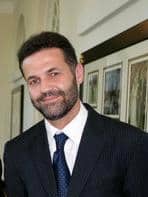A Sustained Discussion Project (2024-2025)
Led by SDP Visiting Fellow, Kenny Andejeski
Overview
Boys and men seem to be experiencing radicalization, violence, and self-harm at an alarming rate. Why? What experience are they having in our society to cause these outcomes? Are we leaving them behind as we strive towards a more inclusive and equitable society? This project explores how societal perspectives, norms, and practices of masculinity influence the disconnection of boys and young men with the aim of imagining new approaches to supporting healthy masculinity.
These issues can be feasibly attributed to trends in disconnection, loneliness, and depression that affect everyone, but have a range of disparate effects on adolescent boys and men. With this in mind, can we reconsider the ways that we include and support boys and men in our society? How might we examine and even redefine the rites of passage they undergo? How might we reimagine ways to define and even celebrate masculinity? How do we dig deeper into our own biases about masculine identity and the power structures that maintain the privilege and pressures it holds?
This Sustained Discussion Project intends to surround the topic of masculinity by bringing together a diverse group of leaders from adjacent fields, like youth development & education, athletics, faith, creative expression, mental health, conflict resolution, and even female empowerment, so that we might explore and discover possible futures for masculine development and inclusion that haven’t been considered yet.
Exploratory Questions
In this discussion project, we will explore a range of questions such as:
- How is masculinity shaped or defined in our society? How is masculinity a product of socialization? How else is masculinity shaped?
- What are common rites of passage for adolescent boys and young men in our society? How do they vary by racial, ethnic, cultural, geographical, or religious groups? What do they intend to do? What do they unintentionally do?
- What are healthy and unhealthy expressions of masculinity? To what extent is this subjective depending on different circumstances, relational and cultural contexts?
- What practices and norms could men’s work and male youth development professionals learn from other identity groups and their respective domains?
- How might the needs of boys and men be met in a way that doesn’t reinforce hierarchies of inequity and oppression, yet honor and uplift them to contribute effectively?
- Why are young men so vulnerable and susceptible to radicalization, extremism and self-harm? What are the conditions we might create to foster healthy inclusion, participation and belonging?
- How do different laws or regulations, like parental leave, the carceral state, mental health access, codify and reinforce or challenge traditional notions of masculinity and femininity?
- How do religious institutions uphold particular kinds of expectations about masculinity?
- What are the polarities that exist between stoicism and sensitivity? Toughness and vulnerability? Competition and cooperation? Domination and submission?
- How can we create spaces that encourage deeper and more emotionally connected friendships among boys and men? What role does male friendship play in combating isolation, radicalization, and other harmful outcomes?
- How do intergenerational dynamics—such as fatherhood, mentorship, and the influence of older figures—shape boys’ and young men’s understanding of masculinity? What shifts might be needed in these relationships to promote healthier models of masculinity? What role should mothers play?
- What role can or should governments, educational institutions, and workplaces play in fostering positive masculine identities?
- How are economic factors such as unemployment, precarious labor conditions, or changing roles in the workforce affecting boys and men’s sense of identity and self-worth? What forms of support can be provided to help men navigate these challenges?
- How has the rise of digital spaces and technologies created new venues for the expression, development, and sometimes distortion of masculinity? How could we address the disconnection or negative influences and actors found in these spaces? And how can we take advantage of the positive influences there?
Summary
This discussion project focuses explicitly on boys and men with an acknowledgement that they have been historically prioritized, centered, and privileged in our society, yet currently are at risk of exclusion, disregard and alienation from our liberal society to the extent that they are causing exceptional harm to themselves and others. The cohort brought together to explore this topic will be asked to maintain a curious and open-minded outlook as we explore possibilities that benefit the whole of society by effectively including and supporting this identity group, rather than expecting them to conform or be left behind.
This discussion project will intentionally engage discussants who have relevant perspectives and work in adjacent fields to masculine development of everyone from adolescent boys to adult men. Subject matter will be sourced and first-hand perspectives will be contributed by leaders and experts in the field of masculine development, but we will explore this topic from the vantage point of the periphery through sustained, online discussions. Our aim will be to create a new facilitation plan and discussion tools to help others explore and imagine the future of healthy masculinity together.
Get Involved
To express interest as a participant, contributor, or advisor for this project, please fill out this form.
To learn more about this project, please contact Kenny Andejeski at [email protected].
Related Resources
- Rebels with a Cause by Niobe Way
- ManKind Podcast by Brandon Clift
- Raised by Wolves by Dana Coester
- Of Boys and Men by Richard Reeves
Want to learn more about what inspired this project?



